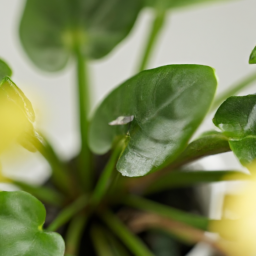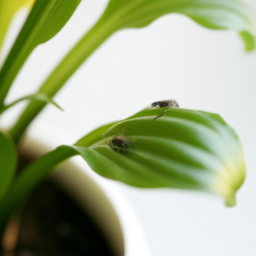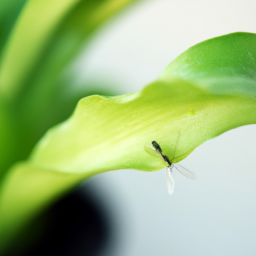
Are you tired of dealing with pesky gnats flying around your indoor plants? You’re not alone! Indoor plants gnats can be a common nuisance for plant lovers, but fear not, because we’ve got you covered. In this blog post, we will explore the world of indoor plants gnats, discussing what they are, why they infest your plants, and most importantly, how to get rid of them. So, if you’re ready to bid farewell to those annoying little insects and restore peace to your indoor garden, keep reading!
Preventing and Treating Gnats in Indoor Plants
Gnats can be a nuisance when they infest your indoor plants. These tiny flying insects can quickly multiply and cause damage to your beloved greenery. However, with the right preventive measures and treatment methods, you can keep your indoor plants gnat-free and thriving. In this guide, we will explore the steps you can take to prevent and treat gnats in indoor plants, ensuring a healthy and pest-free environment for your plants.
Understanding Gnats and their Impact on Indoor Plants
Gnats are small flying insects that belong to the family of flies. They are commonly found in moist environments and are attracted to decaying organic matter. In indoor plants, gnats can cause various issues such as root damage, stunted growth, and even plant death. The larvae of gnats feed on the organic matter in the soil, including the plant’s roots, which can weaken the plant’s overall health. Additionally, adult gnats can also lay eggs in the soil, perpetuating the infestation cycle.
Now that we understand the impact of gnats on indoor plants, let’s dive into the preventive measures you can take to keep them at bay.
Preventing Gnats in Indoor Plants
1. Use High-Quality Potting Soil: Start with a good quality potting soil that is well-draining. Gnats thrive in moist environments, so using a soil mix that retains too much water can create a perfect breeding ground for them. Look for potting soil that is specifically formulated for indoor plants and has good drainage properties.
2. Allow Proper Drainage: Ensure that your pots have drainage holes at the bottom to allow excess water to escape. Overwatering your plants can lead to moisture accumulation, which attracts gnats. Use a saucer or tray under the pot to collect any excess water and empty it regularly to prevent waterlogging.
3. Avoid Overwatering: One of the most common mistakes plant owners make is overwatering their plants. Check the moisture level of the soil before watering and only water when the top inch of the soil feels dry. This will help maintain the right moisture balance and discourage gnats from infesting the soil.
4. Cleanliness is Key: Keep your indoor plant area clean and free from decaying organic matter. Remove fallen leaves, dead flowers, and any other debris regularly to eliminate potential food sources for gnats. Wipe down the pots and surrounding surfaces to prevent any buildup of organic matter.
5. Quarantine New Plants: When introducing new plants to your indoor collection, it’s essential to quarantine them for a few weeks. This allows you to observe if any pests, including gnats, are present before placing them near your existing plants. This precautionary step can prevent the spread of infestations.
Treating Gnats in Indoor Plants
If despite your preventive efforts, you find gnats infesting your indoor plants, don’t worry. There are effective treatment methods you can employ to eliminate them and restore your plants’ health.
1. Sticky Traps: Place yellow sticky traps near your plants to catch adult gnats. The bright color attracts them, and once they land on the sticky surface, they get trapped. This method helps in reducing the adult population.
2. Soil Drench: A soil drench treatment involves using a solution to kill the gnat larvae in the soil. You can make a homemade solution by mixing one part hydrogen peroxide with four parts water and carefully drenching the soil. This treatment helps eliminate the larvae and disrupts the infestation cycle.
3. Neem Oil Spray: Neem oil is a natural insecticide that can effectively control gnats. Mix neem oil with water according to the instructions on the product and spray it on the affected plants. The oil coats the gnats and disrupts their life cycle, eventually eliminating the infestation.
4. Beneficial Nematodes: Beneficial nematodes are microscopic organisms that prey on the larvae of gnats and other pests. These nematodes can be purchased and applied to the soil according to the instructions. They are safe for plants and can help control the gnat population.
5. Let the Soil Dry: Gnats thrive in moist environments, so allowing the soil to dry out between waterings can discourage their growth. Adjust your watering schedule accordingly and ensure that the top layer of the soil is completely dry before watering again.
By following these preventive measures and treatment methods, you can effectively prevent and treat gnats in your indoor plants. Remember to regularly monitor your plants for signs of infestation and take immediate action if you spot any gnats. With a little care and attention, your indoor plants can thrive and remain gnat-free, creating a beautiful and healthy environment in your home.

Natural Remedies for Getting Rid of Gnats in Houseplants
Indoor plants are a great way to bring nature into your home, but they can sometimes attract unwanted guests like gnats. Gnats are tiny flying insects that are commonly found around houseplants. They are not only annoying but can also cause damage to your plants if left untreated. In this article, we will discuss some natural remedies to get rid of gnats in houseplants.
Identifying Gnats
Before we dive into the remedies, let’s first understand how to identify gnats. Gnats are small, flying insects with long legs and wings. They are usually black or gray in color and have a slender body. You may notice them flying around your houseplants or resting on the soil. Gnats are attracted to moist environments, so they tend to lay their eggs in the damp soil of indoor plants.
To confirm if you have a gnat infestation, gently water your plants and observe the soil surface. If you see tiny black insects flying around or crawling on the soil, it’s a clear sign of a gnat problem.
1. Dry Out the Soil
Gnats thrive in moist environments, so one of the most effective ways to get rid of them is by drying out the soil. Allow the top layer of soil to dry completely before watering your plants again. This will help eliminate the breeding ground for gnats and disrupt their life cycle. Be careful not to overwater your plants, as this can create the perfect conditions for gnats to multiply.
In addition to drying out the soil, you can also improve the drainage of your pots. Ensure that your pots have drainage holes at the bottom to prevent water from pooling. You can also add a layer of pebbles or gravel at the bottom of the pot to enhance drainage.
Furthermore, avoid using saucers or trays underneath your pots to catch excess water. These can create a stagnant water source, attracting more gnats to your plants.
2. Use Sticky Traps
Sticky traps are a simple yet effective way to catch and eliminate adult gnats. These traps are available in most garden centers and are easy to use. Simply place the sticky traps near your infested plants, and the gnats will be attracted to the bright color and stick to the trap.
Make sure to position the traps close to the soil surface, as this is where the gnats spend most of their time. Replace the traps regularly as they become filled with gnats. Sticky traps are non-toxic and safe to use around pets and children.
For added effectiveness, you can also create your own homemade sticky traps. Cut yellow or bright-colored cardboard or paper into small rectangles and coat them with a sticky substance like petroleum jelly or honey. Place these homemade traps near your plants and watch as the gnats get trapped.
3. Apply Neem Oil
Neem oil is a natural insecticide derived from the seeds of the neem tree. It is effective against a wide range of pests, including gnats. Neem oil works by disrupting the feeding and reproductive systems of insects, ultimately killing them.
To use neem oil, dilute it according to the instructions on the packaging and spray it onto the soil surface of your infested plants. The oil will not only kill adult gnats but also prevent the larvae from developing into adults. Repeat the application every few days until the gnat infestation is under control.
It’s important to note that neem oil should be used with caution and according to the instructions. Avoid spraying it on the leaves of your plants, as it can cause damage. Additionally, test a small area of your plant before applying neem oil to ensure it doesn’t cause any adverse effects.
By following these natural remedies, you can effectively get rid of gnats in your houseplants. Remember to be patient, as it may take some time to completely eliminate the infestation. Regularly monitor your plants and take preventive measures to avoid future gnat problems.

Best Practices for Maintaining Gnat-Free Indoor Plant Environments
Indoor plants not only add beauty to our living spaces but also provide numerous benefits for our well-being. However, dealing with gnats can be a frustrating challenge for plant enthusiasts. These tiny flying insects can quickly infest indoor plants, causing damage to their roots and making it difficult to enjoy our green companions. In this article, we will explore the best practices for maintaining gnat-free indoor plant environments, ensuring the health and vitality of your beloved plants.
Understanding Gnats and Their Impact on Indoor Plants
Gnats are small, flying insects that belong to the family of flies. They are commonly found in areas with moist soil, making indoor plants an ideal breeding ground. These pests are attracted to decaying organic matter and thrive in warm and humid conditions. Gnats lay their eggs in the potting soil, and once hatched, the larvae feed on the plant roots, causing stunted growth and wilting.
To prevent gnat infestations, it is crucial to understand their life cycle. Gnats have a relatively short life span, typically lasting around four weeks. However, during this time, they can reproduce rapidly, leading to a significant population if not addressed promptly. By implementing the following best practices, you can effectively control and eliminate gnats from your indoor plant environments.
1. Proper Watering Techniques
One of the primary reasons gnats thrive in indoor plants is overwatering. Excess moisture in the soil creates an ideal environment for gnats to lay their eggs and for larvae to flourish. To combat this, it is essential to practice proper watering techniques:
A. Water Only When Necessary: Check the moisture level of the soil before watering. Stick your finger about an inch deep into the soil; if it feels dry, it’s time to water. Avoid watering on a fixed schedule and adjust according to your plant’s needs.
B. Ensure Proper Drainage: Ensure that your pots have drainage holes to allow excess water to escape. Standing water in the saucer or pot can lead to root rot and attract gnats.
C. Remove Excess Water: After watering, empty the saucer to prevent water from accumulating. This will discourage gnats from laying eggs in the moist environment.
2. Soil Maintenance and Prevention
Gnats are often introduced to indoor plants through contaminated soil. By implementing proper soil maintenance and prevention techniques, you can minimize the risk of gnat infestations:
A. Use High-Quality Potting Soil: Opt for well-draining potting soil that is specifically formulated for indoor plants. Avoid using garden soil, as it may contain pests and diseases.
B. Quarantine New Plants: Before introducing a new plant to your indoor environment, quarantine it for a few weeks. This will allow you to monitor for any signs of pests, including gnats, and prevent the infestation from spreading to your existing plants.
C. Regularly Inspect and Replace Soil: Periodically inspect your plants for signs of gnats or larvae. If you spot any, remove the top layer of soil and replace it with fresh, sterile soil to eliminate the eggs and larvae.
3. Natural Remedies and Biological Controls
When dealing with gnat infestations, there are several natural remedies and biological controls that can be used as effective alternatives to chemical pesticides:
A. Sticky Traps: Place yellow sticky traps near your plants to catch adult gnats. The bright color attracts them, and once they land on the sticky surface, they are unable to escape.
B. Cinnamon: Sprinkling cinnamon powder on the soil’s surface can deter gnats from laying eggs. The strong scent acts as a natural repellent.
C. Beneficial Nematodes: These microscopic worms feed on gnat larvae and can be applied to the soil to control the population. Follow the instructions provided with the nematodes for optimal results.
D. Hydrogen Peroxide Solution: Mix one part hydrogen peroxide with four parts water and water your plants with this solution. It helps kill gnat larvae while providing oxygen to the roots.
E. Neem Oil: Neem oil is a natural insecticide that disrupts the life cycle of gnats. Dilute it according to the instructions and spray it on the soil surface and leaves of affected plants.
By incorporating these best practices into your indoor plant care routine, you can create a gnat-free environment that promotes the health and longevity of your plants. Remember, prevention is key, so be proactive in monitoring and addressing any signs of gnat infestations. With proper care and attention, you can enjoy a thriving indoor garden free from these pesky pests.
Essential Points
Indoor plants are a wonderful addition to any home, bringing a touch of nature and a breath of fresh air. However, they can also attract unwanted guests in the form of gnats. These tiny flying insects can quickly become a nuisance, buzzing around the house and even infesting other plants. But fear not, there are simple and natural ways to get rid of these pesky gnats and keep your indoor plants thriving.
One effective method to combat indoor plant gnats is by using a mixture of dish soap and water. Simply mix a few drops of dish soap with water in a spray bottle and generously spritz the affected plants. The soap acts as a natural insecticide, suffocating the gnats and preventing them from reproducing. Another solution is to create a vinegar trap by filling a small container with apple cider vinegar and a few drops of dish soap. The gnats are attracted to the vinegar and get trapped in the mixture. Regularly emptying and refilling the trap will help control the gnat population. Additionally, ensuring proper drainage for your plants and avoiding overwatering can prevent gnats from breeding in the moist soil.
Here are some FAQs you’d be interested in:
Q1: What are gnats and why are they attracted to indoor plants?
A1: Gnats are small flying insects that are commonly found around indoor plants. They are attracted to the moist soil and decaying organic matter found in potted plants. Gnats lay their eggs in the soil, and the larvae feed on fungi and plant roots. The presence of gnats can indicate overwatering, poor drainage, or the presence of decaying organic material in the soil.
Q2: How can I get rid of gnats in my indoor plants?
A2: To get rid of gnats, start by allowing the soil to dry out between waterings. This will help eliminate their breeding grounds. You can also use sticky traps or yellow sticky cards to catch adult gnats. Another effective method is to create a vinegar trap by placing a small dish filled with apple cider vinegar and a few drops of dish soap near the infested plants. The gnats will be attracted to the scent and get trapped in the solution.
Q3: Are there any natural remedies to control gnats in indoor plants?
A3: Yes, there are several natural remedies to control gnats in indoor plants. One option is to sprinkle a layer of sand or diatomaceous earth on the soil surface. This will prevent the gnats from laying eggs in the soil. Another natural remedy is to use beneficial nematodes, microscopic organisms that feed on gnat larvae. You can purchase nematodes from garden centers or online. Additionally, introducing carnivorous plants like sundews or pitcher plants can help control the gnat population.
Q4: Can gnats harm my indoor plants?
A4: While adult gnats themselves do not cause significant harm to indoor plants, their larvae can damage the plant roots and create an unhealthy environment for your plants. If left unchecked, a large population of gnats can weaken the plants and hinder their growth. It’s important to address the gnat infestation promptly to prevent any potential damage to your indoor plants.
Q5: How can I prevent gnats from infesting my indoor plants in the future?
A5: To prevent gnats from infesting your indoor plants, make sure to avoid overwatering. Allow the soil to dry out between waterings, as gnats thrive in moist environments. Ensure your pots have proper drainage to prevent water from accumulating at the bottom. You can also use sterilized potting soil or add a layer of sand on top of the soil to discourage gnats from laying eggs. Avoid leaving decaying organic matter, such as fallen leaves, in the pots as this can attract gnats. Regularly inspect your plants for any signs of infestation and take immediate action if you notice gnats or their larvae.

James Wong is a renowned ethnobotanist, plant scientist, and local television presenter. With a passion for demystifying plant science, he is known for translating complex botanical concepts into practical advice for everyday plant enthusiasts. James’s expertise spans from traditional gardening to cutting-edge plant technologies, making his insights accessible and informative.


